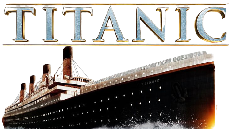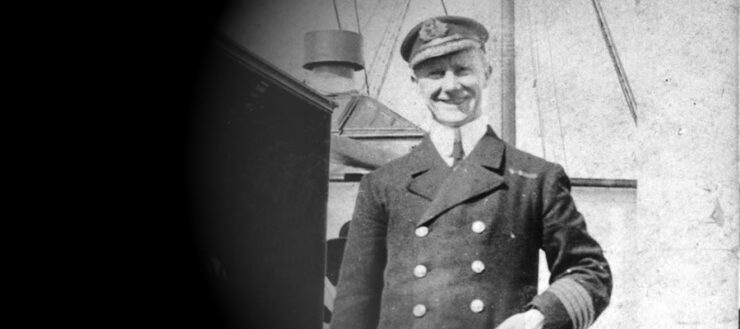‘Hero’ is a word that is often heard when reading or talking about disasters, and all too often the word gets mis-used, especially in the tragic story of the Titanic. But Captain Arthur Henry Rostron of the Cunard Line’s Carpathia could be safely described as a hero, without a hint of doubt. It was Captain Rostron’s swift actions and forward-thinking that saved many, many more lives that night, and his place in the history books was earned in a truly heroic manner.
Arthur Henry Rostron was born in Bolton, Lancashire in 1869. At 17, he served as a cadet aboard the training vessel HMS Conway. He then spent the next 9 years at sea gaining valuable experience aboard various sailing vessels and steamships which took him to all parts of the world.
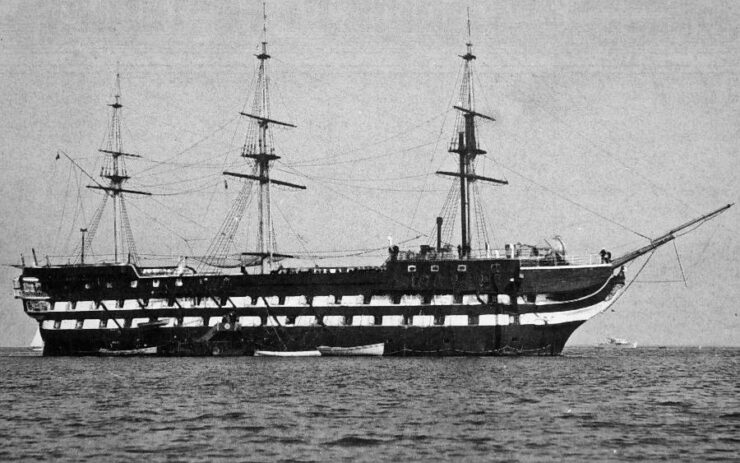
In 1895, Rostron joined the Cunard Line as Fourth Officer of the Umbria, and would remain with them for the best part of 36 years, other than a short spell to undertake his Royal Naval Reserve qualifying drill. He was known throughout Cunard as ‘The Electric Spark’ because of his efficiency and boundless enthusiasm.
He served on various vessels, including Campania, Etruria, Ivernia, Pannonia, Saxonia, Servia and Ultonia, working his way up the ranks until 1907 when Rostron was given his first command, the cargo ship Brescia. He also went on to command Ivernia, Pavonia, Pannonia and Saxonia.
But in January 1912, the Cunard Line gave Rostron his sixth command, Carparthia.
On 11th April, 1912, Carpathia had departed New York for a voyage to the Mediterranean, calling at Gibraltar, Genoa, Naples, Trieste and Fiume.
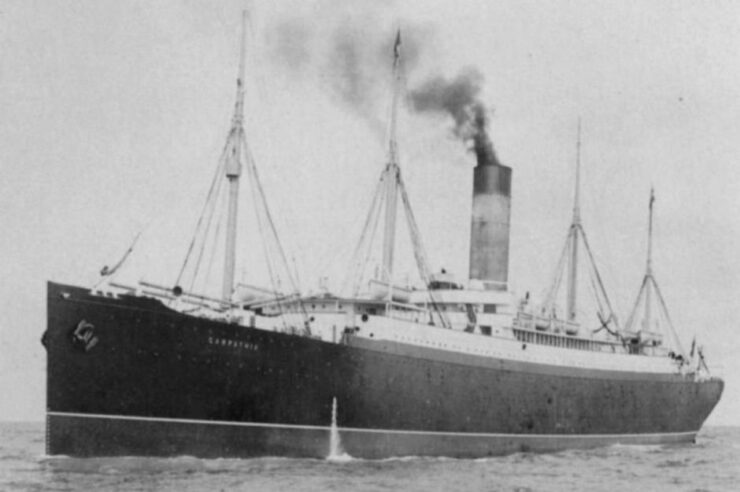
On the night of the 14th April, Captain Rostron himself was in his cabin, so when Harold Cottam, Carpathia’s radio officer, first got Titanic’s distress call, Cottam dashed onto the bridge to find First Officer H. Dean. He told Dean about the Titanic’s call for help, who to Dean’s credit didn’t check out Cottam’s story first. He led Cottam to the Captain’s cabin, and burst in, telling Rostron the dreadful news. Rostron asked Cottam directly if he was sure it was the Titanic in distress, to which Cottam confirmed it was.
Rostron then did something which is often overlooked by many books and films; he ordered Carpathia’s new course before checking that what Cottam was telling him was indeed fact, and not a garbled message of some sort, which was quite possible in those days of early communications, then he worked out the relative positions of both ships and set a more accurate course.
Captain Rostron then began to prepare his vessel for the hours ahead, and the extent of the planning reads like a manual on the subject of rescuing passengers at sea.
This list has been compiled using Walter Lord’s classic book A Night To Remember as a reference.
- Order all off-duty crew to be summoned.
- Chief Engineer to get as much speed as was possible out of ship.
- Turn off steam heating to free up all available steam for more speed.
- Prepare and swing out all lifeboats.
- Setup electric lights alongside ship’s hull.
- Open all gangway doors.
- Setup a block and tackle hoist at each gangway door.
- Setup chair slings for injured.
- Setup canvas bags on hoists to bring aboard children.
- Drop all pilot ladders and side ladders.
- Rig cargo nets at suitable points on ship’s hull.
- Prepare forward steam hoists for bringing mail and luggage aboard.
- Have thick oil ready to poor down lavatories in the event of rough seas.
- Collect all stimulants and medication.
- Setup first aid stations in each respective dining room.
- Allocate people to collect names of survivors as they come aboard.
- Ensure passengers are sent to 1st, 2nd or 3rd class dining room for medical check.
- Allow every crewman to have a hot coffee for the long night ahead.
- Have soup, coffee, tea, brandy and brandy ready for survivors.
- Convert larger public rooms into dormitories.
- Blankets and pillows to be collected from every available place.
- Group all of Carparthia’s steerage passengers together to make room for Titanic’s.
- Keep Carpathia’s passengers in the dark so as to avoid panic.
Of course, much of the above list tragically became irrelevant when the extent of the people lost in the sinking became apparent, but even so, the ever efficient ‘Electric Spark’ had done well, and he would be remembered for his actions for years to come.
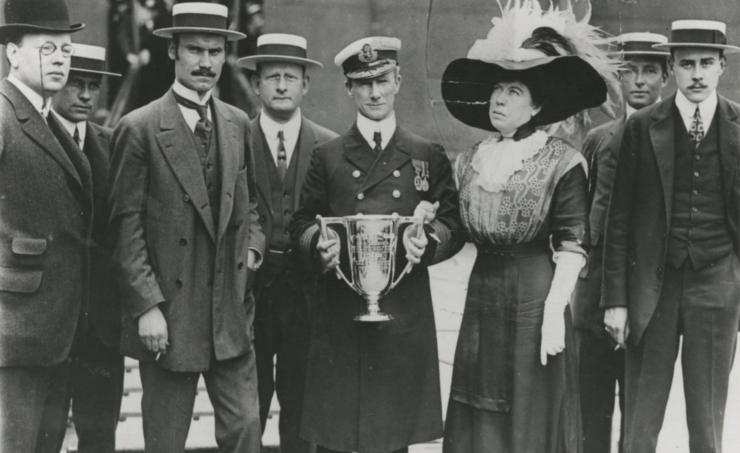
On the journey to New York after the sinking, a committee was created with the intention of suitably rewarding not only the gallant Captain Rostron, but also every member of Carpathia’s crew who were aboard at the time of the rescue. It was chaired by Fred Seward, and the other committee members consisted of Karl Behr, Mrs. Margaret ‘Molly’ Brown, Issac Frauenthal, George Harder, Frederick Oakley Spedden, and Lieutenant Hokan Bjornstrom-Steffansson. They started a collection among Carpathia’s passengers, and once ashore, many more donations were made, swelling the fund to about $15,000, quite a sizable sum in 1912.
Six weeks later, when Carpathia made her first scheduled visit to New York since returning Titanic’s survivors, a ceremony was held aboard her to present each crew member with a specially-struck medal. Captain Rostron was presented with a silver loving cup by Margaret ‘Molly’ Brown, seen here in the picture on the right.
The crew of Carpathia were also rewarded, this time by their employers, the Cunard Line. Each member who was aboard that night were given a month’s wages as thanks and recognition for the way in which they performed under the circumstances.
The following year, Rostron and his wife went to Washington D.C. so that he could receive The Congressional Medal Of Honour, the highest accolade that could be bestowed upon a non-American, which was presented to Rostron by President Taft, who had lost his good friend and aide Major Archibald Butt in the sinking.
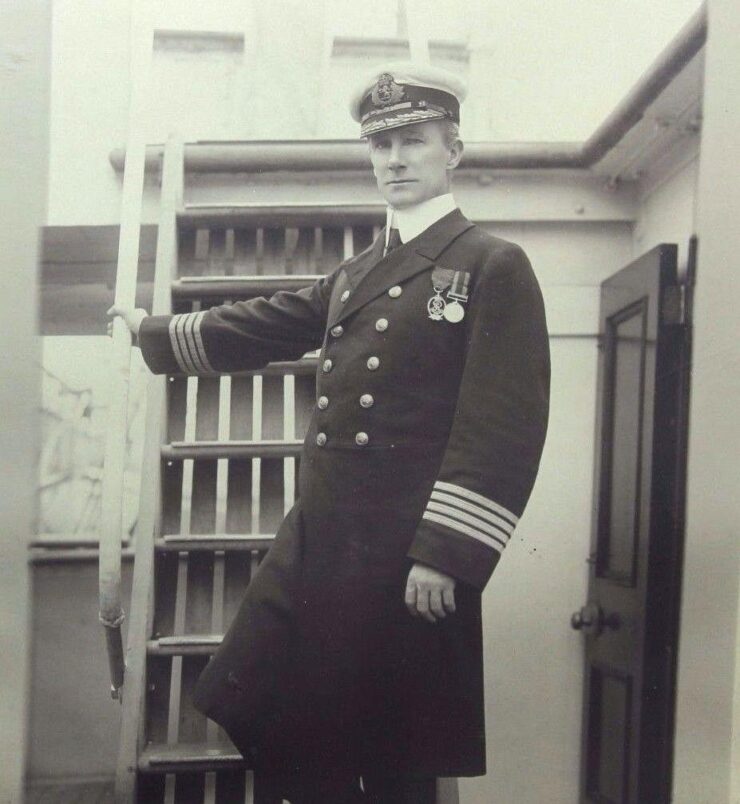
Cunard set about rewarding Rostron, but in a totally different way – in 1915, Captain Arthur Henry Rostron of the Carpathia became Captain Arthur Henry Rostron of the Mauretania, Cunard’s flagship par excellence. Under Rostron’s Captaincy, ‘Maury’ performed some high speed runs across the Atlantic, and at one point held the Blue Riband for a west-bound crossing.
In 1926, Rostron was decorated with a K.B.E, or Knight Commander of The Order of the British Empire, a highly distinguished award only awarded to carefully selected people.
Rostron retired in 1931, and wrote an autobiography called ‘Home From The Sea’, a highly sought-after, though reportedly-lacklustre book, with just the paragraph about Titanic of any real note.
On November 4th, 1940, Rostron passed away, which was largely overlooked due to the atrocities of World War II which filled the newspapers of the time.
